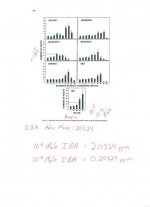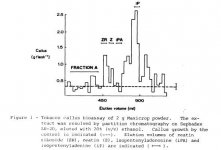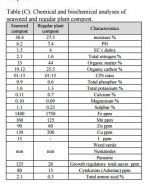-
As of today ICMag has his own Discord server. In this Discord server you can chat, talk with eachother, listen to music, share stories and pictures...and much more. Join now and let's grow together! Join ICMag Discord here! More details in this thread here: here.
You are using an out of date browser. It may not display this or other websites correctly.
You should upgrade or use an alternative browser.
You should upgrade or use an alternative browser.
Advancing Eco Agriculture, Product Science
- Thread starter FatherEarth
- Start date
J
Johnny Redthumb
I think it is super important to copy others, but do so in an analytical way, much like doing trials. We all need funds to support our research. So follow an existing successful method and get your own results in the >80% success range, and then continue to completely dissect and analyze the whys and hows of everything being done. I've done this multiple times over my 11+ years of growing cannabis, and I've always found that a majority of the methods being employed, if working, are not working for reasons initially suggested and/or a majority of it is complete bullshit. This is basically how I have continued to fail upward in this business, learning painful lesson after lesson, from large grow to larger grow, to kicked to the curb and buying my own farm...
Avenger,
Here is a real article, go the first graph, in an ascophylum nodosum everything to the left of say 450 is auxin. Everything to the right is cytokinin.... 1 to 1. No chance.
Maybe with an Eklonia, like Kelpak, that one has much more auxin than cytokinin.
Attachments
I can say I've learned something from everyone. Some of it good, some bad. Not a single product or technique will give a successful crop. I do some random stuff sometimes that I've never even heard of, sometimes I kick myself lol
After getting my sap PH to alot closer I hit my shit with a guano/castings tea and dropped it to 5.9. Today I put a cation fertigation plan to action. After 7 hours the PH was up to 6.2. I can now smell the garden from a distance. Can't wait to take some more readings in the morning. Now that I got most of it down the care level on the remainder has gone up alot. Pretty stoked to be able to do things beside water lmao
Can anyone give me a lil explanation of they're sap ec readings? Its my newest meter so I'm still collecting data and trying to build some sort of baseline. You can obviously see some of them are gonna have a higher reading before you test.
The A/B or mic/mac is a pretty slamming 2 part. However I don't think I'll ever quit using the pacifigro oceanic.
After getting my sap PH to alot closer I hit my shit with a guano/castings tea and dropped it to 5.9. Today I put a cation fertigation plan to action. After 7 hours the PH was up to 6.2. I can now smell the garden from a distance. Can't wait to take some more readings in the morning. Now that I got most of it down the care level on the remainder has gone up alot. Pretty stoked to be able to do things beside water lmao
Can anyone give me a lil explanation of they're sap ec readings? Its my newest meter so I'm still collecting data and trying to build some sort of baseline. You can obviously see some of them are gonna have a higher reading before you test.
The A/B or mic/mac is a pretty slamming 2 part. However I don't think I'll ever quit using the pacifigro oceanic.
View Image
View Image
View Image
Me walkway has disappeared and foliar has become a serious bitch
Blue City Diesel throwing pink pistils
Wow....
Avenger,
Here is a real article, go the first graph, in an ascophylum nodosum everything to the left of say 450 is auxin. Everything to the right is cytokinin.... 1 to 1. No chance.
Maybe with an Eklonia, like Kelpak, that one has much more auxin than cytokinin.
And that study was done with Maxicrop, which is not that good. 100ppm of cytokinin at best. Used them many years ago.
Avenger,
Here is a real article, go the first graph, in an ascophylum nodosum everything to the left of say 450 is auxin. Everything to the right is cytokinin.... 1 to 1. No chance.
Maybe with an Eklonia, like Kelpak, that one has much more auxin than cytokinin.
they reference your paper in my paper. Did YOU read it?
I'm not sure I completely understand the graph you directed me to in the Sanderson & Jameson article you uploaded, though i don't think you do either. I dont think "fraction A" or as you say to the left of 450 is representing auxins. As figure 1 is the tobacco bioassay and they do not mention testing for auxin by bioassay, only cytokinins.
Maxicrop, which is not that good. 100ppm of cytokinin at best. Used them many years ago.
to quote the "real article"
Data on the cytokinin content of Maxicrop published by Williams et al., (1981) indicated extraordinarily high levels of cytokinin (up to 200 mg equivelant kinetin per liter of Maxicrop). Our bioassay data indicate approx 1.3 mg kinetin equiv per liter of Maxicrop.....
fyi
mg/l=ppm
so i find your claim of a natural product with 400 ppm cytokinin very dubious.
Let's step back. First you were saying that you though most seaweeds had the same amount of auxins as cytokinins.
"Your" article disagrees with you.
The Kinetin quantity of the Maxicrop was determined at 20 g-1, the IAA (auxin) fraction was estimated at 6.64 g-1. That is not a 1 to 1 basis. Kinetin is not the only cytokinin, so the article is not that good.
In the article that you didn't understand the graph, the footprints to the left with the solid line above them are the auxins. The others to the right are cytokinins. Sometimes one has to read a scientific article a couple of times to understand them. I was trying to use graphic demonstration for you....
As for the claim of the seaweed manufacturer, I know them and believe them as many of us see the difference over Maxicrop, SM6 and any other in the market. It is not MY seaweed nor my claim, but thanks anyway for the "dubious" comment.
Let's step back. First you were saying that you though most seaweeds had the same amount of auxins as cytokinins.
No, I said "I believe there is always more auxin than cytokinins in any given kelp extract product, no matter the extraction process or species of kelp used." You even quoted me. So please do step back and re-read.
"Your" article disagrees with you.
The Kinetin quantity of the Maxicrop was determined at 20 g-1
your concentration quantification is incomplete.
20 g-1
I pressume you are trying to say 20 micrograms per liter. The way I interpretted the data from "Comparison of cytokinin- and auxin-like activity in some commercially used seaweed extracts, the cytokinin like activity was closer to 50 ug/liter.
50 micrograms per liter is 0.05 ppm
the IAA (auxin) fraction was estimated at 6.64 g-1
again your concentration quantification is incomplete, I presume you intended to say 6.64 micrograms per gram.
This data set is quoted/referenced in the article i linked you too, but it is from a different research project.
It is from Auxin in a Seaweed Extract: Identification and Quantitation of Indole-3-acetic acid by Gas Chromatography-Mass Spectrometry Article in Journal of Plant Physiology 129(s 3–4):363–367 · August 1987, written by the same people your uploaded article is, only a year later. It is when and where they quantified the auxin like activity of the Maxicrop seaweed extract, as they did not do so in the first article THE CYTOKININS IN A LIQUID SEAWEED EXTRACT: COULD THEY BE THE ACTIVE INGREDIENTS?, that you kindly uploaded.
Here is the data on auxin like activity as I interpret it from Comparrison article i linked to.
So lets get this data into ppm so we can compare them with the data on cytokin from above.
6.64 ug/g-1 dry powder= 6.64 ppm Auxin , 5.4 microgram kinetin per gram dry powder, data from from the Sanderson & Jameson project
~2 ppm auxin according to the Strik & Staden comparison article i linked you too. compared to the cytokin concentration of 0.05 ppm.
This is in agreement with my statement:
"I believe there is always more auxin than cytokinins in any given kelp extract product, no matter the extraction process or species of kelp used."
Attachments
Last edited:
In the article that you didn't understand the graph, the footprints to the left with the solid line above them are the auxins. The others to the right are cytokinins. Sometimes one has to read a scientific article a couple of times to understand them. I was trying to use graphic demonstration for you....
"Any cytokinin like activities eluting earlier than zeatin riboside (Fraction A) may have been masked by impurities."
And you say fraction A is the auxin fraction from the extraction?
You are misunderstanding their graphical demonstration. As I said earlier it is the activity of cytokin from the bioassay. They did not present any data for activity of auxin from bioassay until the next years paper. They only confirmed auxins presence in the seaweed extract by chromotography in the 1986 article.
Auxin in a Seaweed Extract: Identification and Quantitation of Indole-3-acetic acid by Gas Chromatography-Mass Spectrometry
Article in Journal of Plant Physiology 129(s 3–4):363–367 · August 1987
Attachments
Last edited:
Avenger...just to be sure...are you talking koh extraction or even just sun dried meal?
Do you have an opinion on Coot's corn seed sprout tea? Is it really high cytokinin
I don't fully understand the first question. But I will say that yes auxin will be higer than cytokin in kelp meal, just like kelp extract.
Attachments
No, I said "I believe there is always more auxin than cytokinins in any given kelp extract product, no matter the extraction process or species of kelp used." You even quoted me. So please do step back and re-read.
your concentration quantification is incomplete.
I pressume you are trying to say 20 micrograms per liter. The way I interpretted the data from "Comparison of cytokinin- and auxin-like activity in some commercially used seaweed extracts, the cytokinin like activity was closer to 50 ug/liter.
View Image
50 micrograms per liter is 0.05 ppm
again your concentration quantification is incomplete, I presume you intended to say 6.64 micrograms per gram.
View Image
This data set is quoted/referenced in the article i linked you too, but it is from a different research project.
It is from Auxin in a Seaweed Extract: Identification and Quantitation of Indole-3-acetic acid by Gas Chromatography-Mass Spectrometry Article in Journal of Plant Physiology 129(s 3–4):363–367 · August 1987, written by the same people your uploaded article is, only a year later. It is when and where they quantified the auxin like activity of the Maxicrop seaweed extract, as they did not do so in the first article THE CYTOKININS IN A LIQUID SEAWEED EXTRACT: COULD THEY BE THE ACTIVE INGREDIENTS?, that you kindly uploaded.
Here is the data on auxin like activity as I interpret it from Comparrison article i linked to.
View Image
So lets get this data into ppm so we can compare them with the data on cytokin from above.
6.64 ug/g-1 dry powder= 6.64 ppm Auxin , 5.4 microgram kinetin per gram dry powder, data from from the Sanderson & Jameson project
~2 ppm auxin according to the Strik & Staden comparison article i linked you too. compared to the cytokin concentration of 0.05 ppm.
This is in agreement with my statement:
"I believe there is always more auxin than cytokinins in any given kelp extract product, no matter the extraction process or species of kelp used."
This is not good science. Read the second paragraph under
4. Discussion. Williams found 200 mg of Kinetin per liter of the same Maxicrop product! These guys in NZ only found 1.3 mg of Kinetin.
Bad labs and bad science. I didn't do the math. Congratulations for doing the math.

I have done test rows over and over of both synthetic and natural cytokinin sources as well as auxins, for many many years. I know what I like and what I see.
Surely if you keep hunting the internet, you will find all kinds of stuff regarding ascophylum nodosum. Maxicrop is a biproduct of the icecream emulsifier business, known for having low cytokinin content. Looking at articles regarding garbage are garbage articles.
Keep digging and see what you can find.
Believing everything you see in an article that establishes on its' own that its' results are off, is not something to base your beliefs in. One can get in a world of confusion that way.
No, I said "I believe there is always more auxin than cytokinins in any given kelp extract product, no matter the extraction process or species of kelp used." You even quoted me. So please do step back and re-read.
your concentration quantification is incomplete.
I pressume you are trying to say 20 micrograms per liter. The way I interpretted the data from "Comparison of cytokinin- and auxin-like activity in some commercially used seaweed extracts, the cytokinin like activity was closer to 50 ug/liter.
View Image
50 micrograms per liter is 0.05 ppm
again your concentration quantification is incomplete, I presume you intended to say 6.64 micrograms per gram.
View Image
This data set is quoted/referenced in the article i linked you too, but it is from a different research project.
It is from Auxin in a Seaweed Extract: Identification and Quantitation of Indole-3-acetic acid by Gas Chromatography-Mass Spectrometry Article in Journal of Plant Physiology 129(s 3–4):363–367 · August 1987, written by the same people your uploaded article is, only a year later. It is when and where they quantified the auxin like activity of the Maxicrop seaweed extract, as they did not do so in the first article THE CYTOKININS IN A LIQUID SEAWEED EXTRACT: COULD THEY BE THE ACTIVE INGREDIENTS?, that you kindly uploaded.
Here is the data on auxin like activity as I interpret it from Comparrison article i linked to.
View Image
So lets get this data into ppm so we can compare them with the data on cytokin from above.
6.64 ug/g-1 dry powder= 6.64 ppm Auxin , 5.4 microgram kinetin per gram dry powder, data from from the Sanderson & Jameson project
~2 ppm auxin according to the Strik & Staden comparison article i linked you too. compared to the cytokin concentration of 0.05 ppm.
This is in agreement with my statement:
"I believe there is always more auxin than cytokinins in any given kelp extract product, no matter the extraction process or species of kelp used."
Couldn't help but note that you didn't sum the cytokinins (not good science) and you chose to use one of the worst cytokinin sources in your example.
plantingplants
Active member
Are there sources of synthetic or extracted kinetin or zeatin? Too cost-prohibitive?
What about 6-BAP?
What about 6-BAP?









